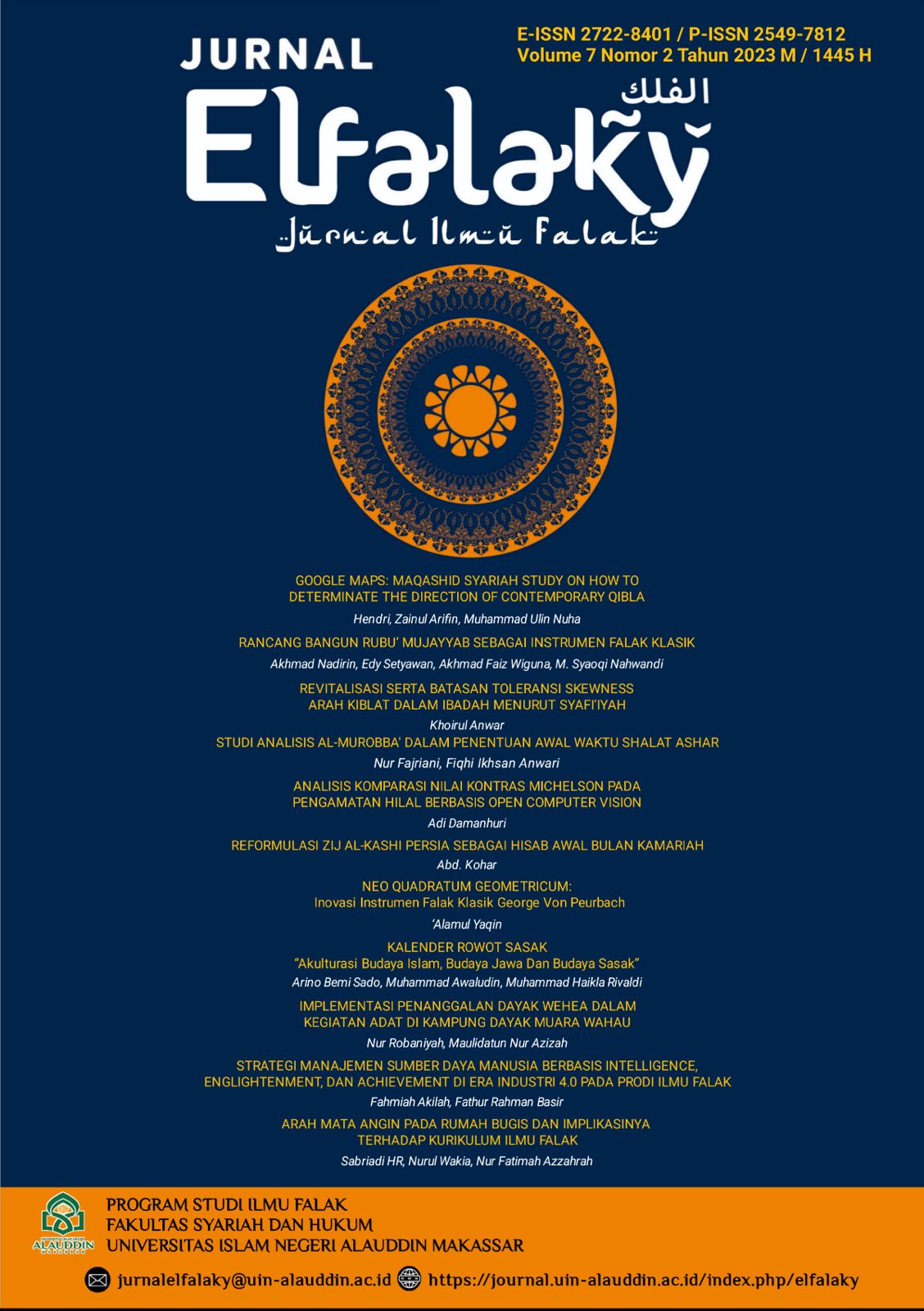IMPLEMENTASI PENANGGALAN DAYAK WEHEA DALAM KEGIATAN ADAT DI KAMPUNG DAYAK MUARA WAHAU
Abstract
The Wehea Dayak is one of the Dayak tribes that still exist today. The Wehea Dayak tribe lives in close proximity to nature. They depend on the surrounding rivers, mountains, and forests. Daily activities cannot be separated from farming and hunting. This activity has a close relationship with the Dayak Wehea traditional activities. In determining the time of traditional activities, the Wehea Dayak people still use the Wehea Dayak calendar, which is a legacy from their previous ancestors. The Dayak Wehea calendar is unique among most calendars in Indonesia. The Wehea Dayak calendar only has two elements, namely the 29/30 months and the 10 periods. The Wehea Dayak calendar does not recognize years like other calendars. This research examines how the Dayak Wehea calendar is implemented in the traditional activities and rituals of the Dayak Wehea community in Muara Wahau District. This research is field research conducted in Muara Wahau District in August and December 2017. This research uses a qualitative approach to describe the research results. The results of this research explain that the Wehea Dayak people use this calendar for ten periods, which refers to traditional activities. This implementation includes determining the cutting period (Nep bloh), farming time (Nemeq), time to plant rice (Nugal), rituals in the fields (Entaglel), the ritual of welcoming the rice that begins to contain (Embeq Hemin Plai), harvest time (Neljiang), the period of completion of harvest (Mel Haq Pangseh May), rice feast (Erau/Lom Plai), time to make a hut (Naq Jengea), and finally the children's era/wedding party (Nak Lom).
References
Ahmad, A. F., Fatmawati, A., & Qulub, S. T. (2022). Implementasi Taqwim Standar Indonesia Sebagai Pemersatu Kalender Masyarakat Indonesia. AL –AFAQ Jurnal Ilmu Falak Dan Astronomi, 4(2). https://journal.uinmataram.ac.id/index.php/afaq/article/view/4166/2245
Al-Azhar, M. (2018). Kalender Hijriyah dalam Al-Qur’an. Al-Marshad, Jurnal Astronomi Islam dan Ilmu-Ilmu Berkaitan, 4(2). https://jurnal.umsu.ac.id/index.php/almarshad/article/view/2479
Angkat, A. (2017). Kalender Hijriyah Global dalam Perspektif Fikih. Al-Marshad,Jurnal Astronomi Islam dan Ilmu-Ilmu Berkaitan, 3(2). https://jurnal.umsu.ac.id/index.php/almarshad/article/view/1524/1569
Awaludin, M. (2019). Kalender Rowot Sasak (Kalender Tradisi Masyarakat Sasak). AL –AFAQ Jurnal Ilmu Falak dan Astronomi, 1(1). https://journal.uinmataram.ac.id/index.php/afaq/article/view/1859
Azhari, S. (2007). ILMU FALAK Perjumpaan Khazanah Islam dan Sains Modern. Suara Muhammadiyah.
Darsono, R. (2010). Penanggalan Islam Tinjauan Sistem Fiqih dan Hisab Penanggalan. LABDA Press.
Delin, L. (2017, Agustus). Masa dalam Penanggalan Dayak Wehea [Personal communication].
Fatmawati, E. (2022). Sistem Penanggalan Candra Sunda dalam Akulturasi antara Budaya Sunda dengan Islam. Jurnal Adat dan Budaya Indonesia, 4(1). https://ejournal.undiksha.ac.id/index.php/JABI/article/view/42061
Gobang, P. W. (2022). Makna Simbolis dan Fungsi Tari Hudoq Suku Dayak Wehea di Pedalaman Kalimantan Timur. Jurnal Komunikasi dan Budaya, 3(2). http://journal.unbara.ac.id/index.php/JKB/article/view/1758/1200
Idrus. (2017, Desember). Sejarah Awal Kalender Dayak Wehea [Personal communication].
Irawan, D. (2017). Kepemimpinan Kepala Adat dalam Mempertahankan Gotong Royong Masyarakat Adat Dayak Wehea di Desa Nehes Liah Bing Kecamatan Muara Wahau. eJournal Pemerintahan Integratif, 5(4). http://ejournal.pin.or.id/site/wp-content/uploads/2017/11/pin_dedi%20(11-14-17-09-52-17).pdf
Izzuddin, A. (2015). Sistem Penanggalan. CV. Karya Abadi Jaya.
Khazin, M. (2008). Ilmu Falak dalam Teori dan Praktik. Buana Pustaka.
Mengenal Acara Adat Lom Plai Lebih Dekat. (2023, Mei). Kutaitimurkab.go.id. https://www.kutaitimurkab.go.id/page/articles/1634
Mulyani, S. (2022). Petkuq Mehuey: Kearifan Lokal dengan Kesetaraan Gender dalam Menjaga Hutan Adat Suku Dayak Wehea-Kutai Timur, Kalimantan Timur. Jurnal Sosial Politika, 3(2). https://jsp.fisip-unmul.ac.id/site/index.php/jsp/article/view/52/32
Ping, Y. Y. (2017, Agustus). Asal-Usul kata Wahau [Personal communication].
Ramdhani, F. Z. (2020). Eksistensi Kalender Bali dalam Kultur Sosial Masyarakat Multireligius Bali. Religious: Jurnal Studi Agama-Agama dan Lintas Budaya, 4(2). https://journal.uinsgd.ac.id/index.php/Religious/article/view/8593
Robaniyah, N. (2018). Sistem Penanggalan Dayak Wehea Kalimantan Timur dalam Perspektif Ilmu Falak dan Astronomi [Thesis (S1), Universitas Islam Negeri Walisongo]. http://eprints.walisongo.ac.id/id/eprint/8006/1/1402046090.pdf
Robaniyah, N., Hidayat MJ, N., Apria Ningrum, V., & Afina Ulya, N. (2023). Identitas Dan Keragaman Dalam Tarian Hudoq: Tinjauan Moderasi Beragama Berbasis Warisan Leluhur Pada Suku Dayak. An-Nida’, 47(1).
Setyaningrum, P. (2022, Agustus). Mengenal Suku Dayak, dari Asal Usul hingga Tradisi. Kompas.com. https://regional.kompas.com/read/2022/08/25/175141478/mengenal-suku-dayak-dari-asal-usul-hingga-tradisi?page=all
Soekamto, S. (1986). Pengantar Penelitian Hukum. UI Press.
Sugiyono. (2016). Metode Penelitian Kuantitatif, Kualitatif, dan R&D. Alfabeta.
Suryanto, B. (2005). Metode Penelitian Sosial. Kencana.
Wing, Y. (2017, Desember). Mengenal Waktu permulaan Masa Penanggalan Dayak Wehea [Personal communication].





